- Whales are entering the Sea of Cortez for their annual migration to feed and breed in the warm smooth waters of this beautiful blue paradise for sea life. Here are 19 of hundreds of fascinating facts about earth’s largest creatures:
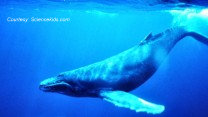
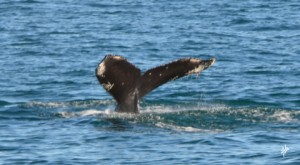
- Whales belong to the order cetacean, meaning they are mammals that are fully adapted to aquatic life. Like dolphins and porpoises, whales are believed to have descended from land animals that returned to the water roughly 50 million years ago after living millions of years on land.
- There are approximately 80 different species of whale with two suborders to which all species of whales belong: toothed whales and baleen whales. Toothed whales include sperm, killer, and beluga whales, and they prey on large fish in deep waters as their main source of food. Baleen whales include blue and humpback whales, and they are filter feeders that feed on small organisms such as krill and plankton by straining large amounts of sea water through a comb-like structure in their mouth called a baleen
- Whales breathe voluntarily, unlike human beings. Since they have to remember to breathe, researchers believe humpback whales sleep by shutting off half of their brain at a time. Because whales must rise to the surface often to breathe, only one half of their brain sleeps at a time. This process allows their body to get adequate rest while still providing for the necessary function of breathing to survive.
- Whales that are found in both Northern and Southern hemisphere never meet or breed together. Their migration is timed so that they are never in breeding areas at the same time.
- The age of a whale can be estimated by looking at the wax plug in its ear. This plug has a pattern of layers when cut lengthwise
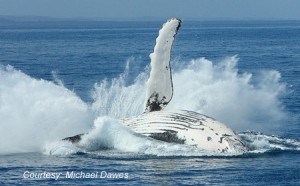 that scientists can count to estimate the age of the whale. Whales can live as long as some humans—and much longer if that human is the one whose job it is to estimate the age of a whale by slicing the wax plug in its ear!
that scientists can count to estimate the age of the whale. Whales can live as long as some humans—and much longer if that human is the one whose job it is to estimate the age of a whale by slicing the wax plug in its ear!
- Whale calves gain much of their weight while they are nursing, consuming 100 pounds a day of their mother’s rich milk which consists of 45% to 60% fat. A blue whale calf will gain as much as 250 pounds a day during the first three weeks of its life.
- Orcas, also known as Killer Whales, are the fastest of all whales with speeds up to 35 miles per hour. Only tuna, marlin, sailfish and swordfish are faster. They are also one of the top predators in the marine world, feeding mostly on fish, but some hunt seals, sea lions, and walruses. Orcas, as do most toothed whales, use echolocation to hunt their prey, bouncing a clicking sound off a nearby object, such as a squid, and measuring the time it takes for the echo to travel back. Hearing is a vital sense in the dark depths of the ocean.
 Pilot Whales and Killer Whales have the word “whale” in their name, but for classification purposes, they are actually considered dolphins.
Pilot Whales and Killer Whales have the word “whale” in their name, but for classification purposes, they are actually considered dolphins.
- Some cultures see whales as divine beings, such as in some places in Ghana and Vietnam, who occasionally hold funerals for beached whales.
- The Blue Whale is the largest known mammal that has ever lived on earth, with a length of up to 105 ft long and weight of 150 tons or more. That’s the weight equivalent of 150 small cars and the size of a 737 commercial airliner.
- Though the blue whale can weigh over 200 tons, it feeds exclusively on krill—a crustacean smaller than a child’s finger.
- When a blue whale dives into the water, its head is already deeper than most scuba divers dare to go before its tail leaves the
 surface of the water.
surface of the water.
- Sperm whales can dive as deep as two miles into the water, and their bodies have unique physiological adaptations to allow them to survive the intense cold and crushing pressure of these dives. They can limit circulation to the brain and other organs, slow the heart to 10 beats per minute to conserve oxygen, and collapse the lungs and rib cage to withstand pressure.
- The humpback whale is one of the most easily recognized whale species. Reaching between 40 and 50 feet in length, a humpback whale can weigh up to 48 tons. They are identified from other whales due to their large flippers, almost one-third of their body size, and the hump on their backs. Humpback whales are anywhere from a gray to black color and have white markings on their underside that differ in every whale like fingerprints, allowing
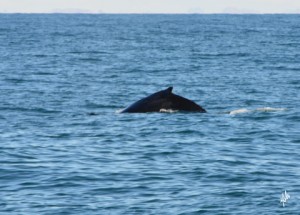 researchers to identify individuals.
researchers to identify individuals. - Humpback whales only eat in summer, feeding off their fat reserves during the winter. When they do eat, however, they can eat up to a ton of food daily. Calves can eat 100 pounds of their mother’s milk a day.
- The larger baleen whales were preferred targets of whalers until they were declared an endangered species in 1966, which protected the remaining populations. By 1986 a moratorium on commercial fishing for whales was instituted, at a time when 9 of the 11 species of baleen whales were in danger of extinction.
- One of the most interesting behaviors of the Humpback is their acrobatics in which they raise their huge flukes (tails) out of the water and slap them loudly on the surface, called “tail lobbing” and “flipper slapping” (using their flippers to slap the water). They are also known for their ability to completely clear the water, called breaching, using their flukes for a power source to propel them above the surface. Humpbacks breach more than any other whale. It is believed this is a method of communication between humpbacks in addition
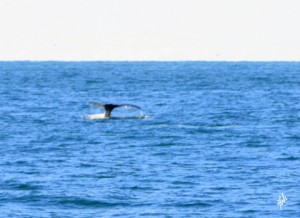 to the use of sonar.
to the use of sonar.
- Tail lobbing is different than “fluking”, which is when a whale raises it fluke out of the water as it initiates a deep dive. Because each whale species’ tail has unique features, fluking allows whale observers to identify species at a distance.
- Perhaps the most interesting—and most baffling to scientists—behaviors of baleen whales is their incredible ability to sing in a range of haunting tones that can be heard up to 20 miles away under water. The bass notes of a baleen whale are the loudest natural sounds made by any animal. It is believed that the songs, which can last for 20-30 minutes and repeated exactly note for note over and over again, are mating songs. Whales in the Atlantic sing a different song than those in the Pacific. Each year the song changes slightly. Scientists believe this talent speaks highly to the superior intelligence of whales.
Whales are not only the largest creatures in existence on earth; they are arguably the most interesting. There are hundreds more fascinating facts about the whale, maybe for a future blog.
You can also read more about whales at:
http://animal.discovery.com/tv-shows/wild-kingdom/about-animals/humpback-humpback-facts.htm;
http://www.seashepherd.org/lightbox_pages/humpback_whale.php?
http://www.alphawhalewatch.com/whales/10-fun-whale-facts
This blog is powered by www.sonoranresorts.mx, Jim Ringquist, Director of Sales and Marketing.

